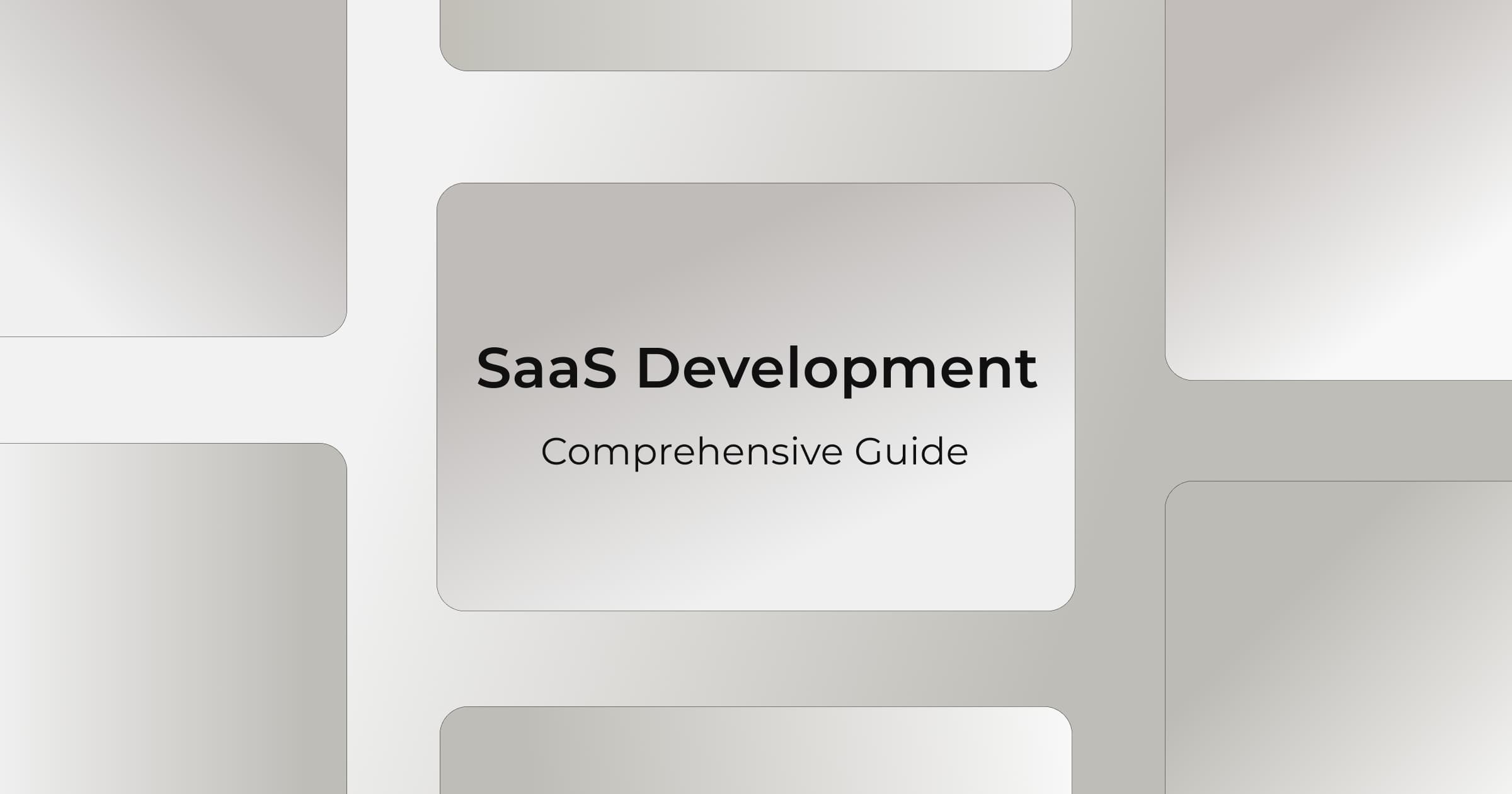
The global SaaS software market was valued at $358.33 billion in 2024 and is expected to grow to approximately $1,251.35 billion by 2034, with a CAGR of 13.32%. This growth can be explained by the fact that, rather than hiring specialists to deploy and configure on-premise digital products, modern businesses are better off purchasing a license for software that is accessible from any web browser. Below, as a company specializing in SaaS based application development, we’ll share our insights related to this topic.
What Is SaaS Application Development
SaaS application development involves creating software that end users access through the cloud according to a subscription model. Unlike traditional desktop software, SaaS solutions are accessible from any browser, meaning they are independent of the end user's infrastructure, which, in turn, reduces support costs and ensures high flexibility when updating.
SaaS architecture traditionally includes a presentation layer, an application logic layer, and a data layer. More complex approaches also exist: these are microservices (where each function is broken down into small, autonomous services) and multi-tenant architecture (where a single app instance needs to efficiently serve multiple clients).
The main SaaS segments are customer relationship management, enterprise resource planning, human capital management, content, collaboration, and communication, as well as business analytics, which is understandable given the need for businesses of all sizes to quickly automate routine workflows and minimize the impact of human error. At the same time, regardless of the application area, developing such software requires access rights configuration, integration with external service APIs, and the ability to customize it for the corporate processes of each individual business.
Key Characteristics of SaaS Platforms
SaaS solutions have several differences from conventional software. For example, they are accessible online and operate on a subscription model, eliminating the need for installation, manual updates, and infrastructure maintenance. They can also automatically scale to meet load and allow for centralized user management, integration with external APIs, analytics collection, and monitoring.
Compared to on-premise solutions, SaaS ones differ in their ownership model and update method. Specifically, SaaS platforms require installation on their own servers (including updates) and regular administration costs, while SaaS alternatives offer centralized management, automated updates, and a predictable pricing model, which depends on the number of users and enabled functionality.
Why Build a SaaS Product: Core Advantages
The SaaS format offers businesses a number of advantages, which we'll discuss in more detail below.
Flexible Development & Iteration
If a team adheres to a microservices approach, they can release updates to the SaaS platform continuously, without requiring manual installation by users. This unlocks the benefits of an iterative approach based on CI/CD practices – in particular, developers gain the ability to quickly test hypotheses, collect feedback, and implement improvements through automated build, testing, and deployment stages.
Scalable Revenue Model
SaaS platforms are oriented toward a subscription-based or pay-per-use model, which generates a stable cash flow and ensures long-term customer relationships. Furthermore, by breaking down functionality to implement tiered pricing, your SaaS solution can serve both SMBs and enterprises.
Performance & Efficiency Benefits
The SaaS architecture optimizes performance by centralizing computing resources and effectively managing workloads. In particular, automatic server scaling, data caching, and traffic balancing ensure stable operation even under peak end-user loads.
Step-by-Step Guide to Building a SaaS Application
Now, let's find out how to build a SaaS application.
Step 1. Planning & Market Validation
At this stage, the development team defines the SaaS’s target audience, analyzes competitors, and creates a unique selling proposition that addresses the end users’ pain points. All this is done before large-scale development investments, to avoid wasting money on something the target audience won't see value in.
Step 2. Technical Foundation & Security
This stage includes choosing the architecture, technology stack, and scaling approaches. For example, we recommend starting with a multi-tenant architecture, as well as implementing cloud containerization, data encryption, access control, and auditing. Additionally, at this phase, you should choose mechanisms to ensure compliance with GDPR or SOC 2 regulations.
Step 3. Design & Development
The team moves on to interface design and programming. For example, UI/UX design determines how user-friendly the product is, while programming includes the creation of microservices, API implementation, integration setup, and admin panel development.
Step 4. Testing & Deployment
Before the release, the team must conduct functional, load, integration, and security testing to ensure the SaaS platform operates correctly under various use cases and loads. The deployment is typically automated through CI/CD pipelines to release updates without disrupting the solution’s work. Afterward, monitoring of performance metrics, usage, resources, and user behavior is set up.
Step 5. Launch, Scale & Optimize
After launching a SaaS solution, the team begins to gradually scale its architecture, optimize performance, fix post-release bugs, and make improvements based on user feedback (collected both directly through surveys and analytics platforms).

Common Challenges in SaaS Development
While knowing how to build a SaaS platform, it makes sense to also consider the challenges that may accompany the process.
Understanding Customer Needs
Often, tech teams focus on functionality instead of assessing the significance of the problem the SaaS solution solves. To avoid this, it's necessary to conduct user interviews, analyze the behavior of the first real users, and optimize the product strategy based on the information obtained.
Building the Right Team
In addition to developers (both frontend and backend), the team must also include specialists in architecture, DevOps, UX design, QA, and data analytics – otherwise, a lack of necessary competencies may lead to problems with further scaling of the platform.
Technology Selection
The choice of technology stack determines the performance, security, and scalability of a SaaS platform – otherwise, you risk costly redesigns. That's why it's so crucial to choose tools that natively support microservices architecture, cloud APIs, and horizontal scaling.
Cloud Migration Strategy
Many businesses are migrating to the SaaS model from existing on-premise solutions, meaning you should plan ahead for a migration strategy that includes data transfer, backups, step-by-step synchronization, automated testing, API compatibility, and minimized downtime.
SaaS Development Team Roles and Structure
A SaaS product development team should be structured so that each role contributes to ensuring its stability, scalability, and valuable business results for the owner. Typically, it includes the following roles:
- Product Owner – this person is responsible for formulating project goals, determining the value of each feature, and setting priorities;
- Project Manager – this specialist coordinates processes, manages deadlines, risks, and communication between teams, ensuring continuous progress monitoring and the team's adaptation to changing client requirements;
- System Architect – this expert builds the microservices structure, as well as selects databases, APIs, security, and scaling mechanisms, etc.;
- Frontend Developers – these specialists are responsible for the user interface, including its logic, visual elements, and responsiveness;
- Backend Developers – they implement business logic, ensure data management, and are responsible for security and integration;
- DevOps Engineers – these team members automate the processes of deployment, testing, and product updates by building CI/CD pipelines and introducing containerization;
- UI/UX designers – these experts handle the visual and behavioral aspects of the interface to make it as intuitive as possible;
- QA engineers – this category of specialists ensures product quality by verifying the correct operation of all modules, as well as assessing performance and security.
You may also need Data Engineers and AI/ML specialists (to work with data, analytics, and highly-intelligent modules), as well as Security Experts (for enhanced information security oversight to ensure compliance with industry regulations such as GDPR/SOC 2).
Selecting Technology Stack and Engineering Tools
The way on how to build a SaaS app is largely determined by its technology stack.

Core Development Technologies
Most SaaS solutions are built on languages and frameworks that ensure high development speed and scalability. For example, we consider Node.js/Go/Java/Python (for the backend) and React/Vue.js/Angular (for the frontend) to be in this category. As for creating APIs, REST and GraphQL are most commonly used.
Infrastructure & Data Management
In terms of the most reliable cloud vendors, we recommend considering AWS, Google Cloud, and Microsoft Azure, with containerization via Docker and Kubernetes. Regarding data management, relational (such as PostgreSQL and MySQL) and NoSQL (such as MongoDB and DynamoDB) solutions are most often used, while streaming analytics systems like Kafka or Snowflake are helpful for processing large data sets.
DevOps & Automation
DevOps tools significantly reduce time to market and speed up update releases. In particular, modern development teams often use Jenkins, GitLab CI/CD, Terraform, and Ansible – together, they automate testing, deployment, and monitoring, while simplifying server scaling, backup implementation, and infrastructure metrics monitoring.
Estimating the Cost of SaaS Development
The cost of SaaS development depends on the complexity of the architecture, integrations, security level, and the development team's pricing policy. On average, creating an MVP SaaS product requires an investment of $50,000-$150,000, while a fully-fledged version based on a scalable architecture, enriched with analytics, multi-level user access, and advanced features, can cost about $150,000-$500,000. Ultimately, for an accurate budget estimate, it's best to contact your tech partner directly.
Should You Partner with a SaaS Development Expert?
Collaborating with a technical partner with extensive experience in SaaS development is the ideal option for businesses that don’t want to have an in-house team. CheIT specializes in creating SaaS platforms of any complexity and for any business needs. You can delegate to us architecture development, DevOps implementation, and the creation of both basic and advanced functionality (for example, based on artificial intelligence and/or machine learning). So, if you'd like to build a sustainable digital business model, rather than just launch a SaaS, email or call us, and we'll discuss your business idea in more detail.
.png)








